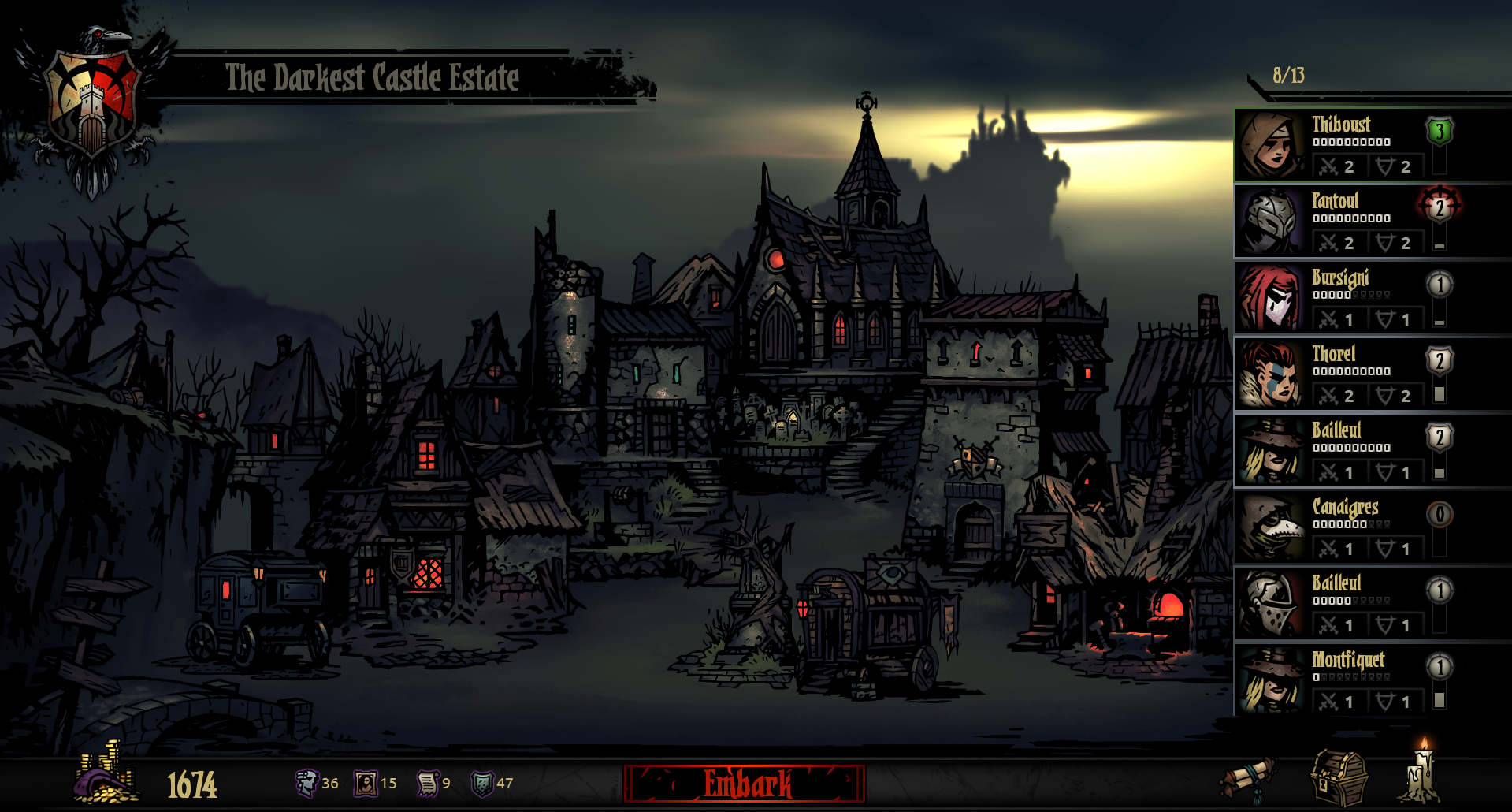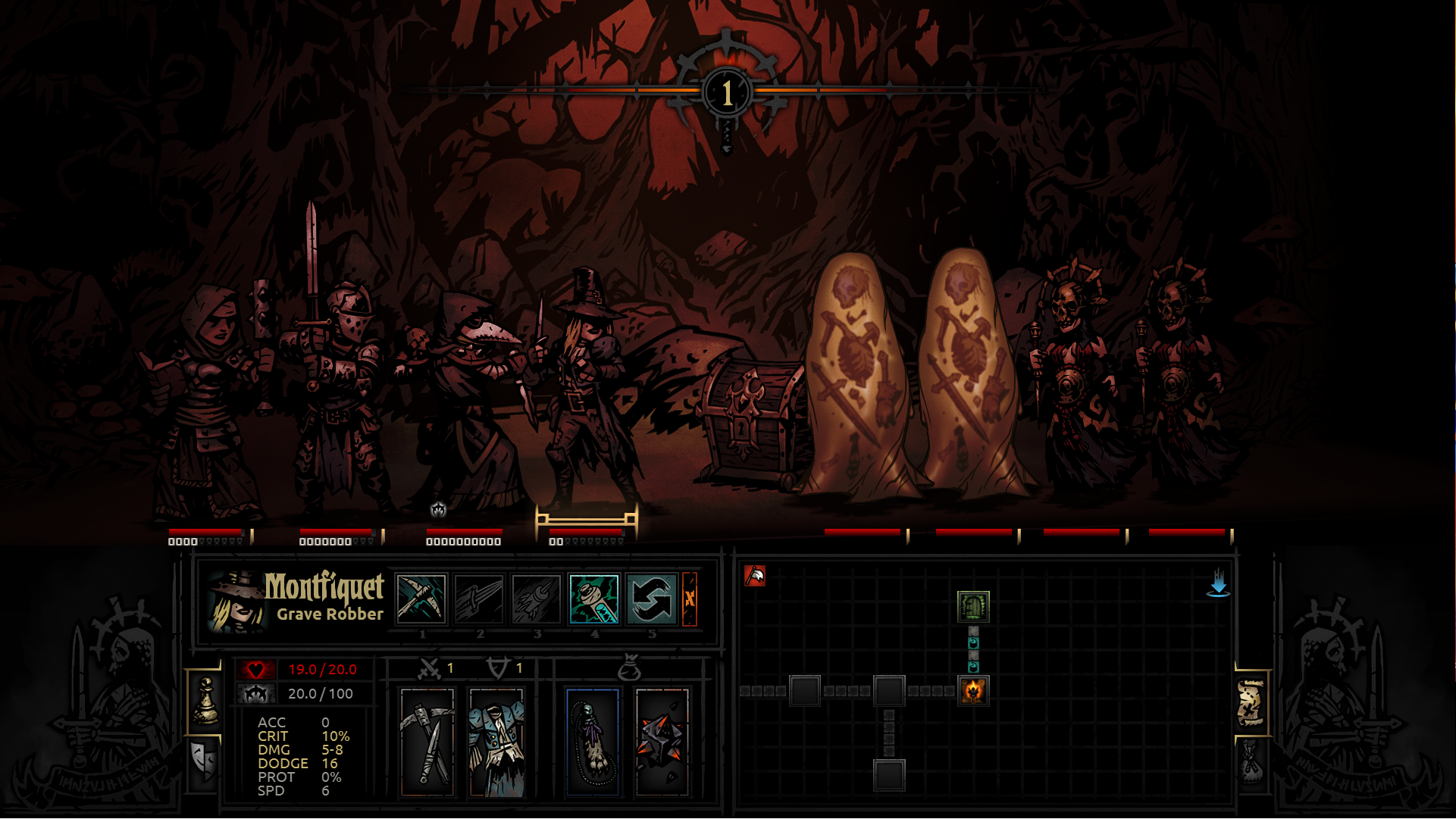Search
[{{{type}}}] {{{reason}}}
{{/data.error.root_cause}}{{{_source.title}}} {{#_source.showPrice}} {{{_source.displayPrice}}} {{/_source.showPrice}}
{{#_source.showLink}} {{/_source.showLink}} {{#_source.showDate}}{{{_source.displayDate}}}
{{/_source.showDate}}{{{_source.description}}}
{{#_source.additionalInfo}}{{#_source.additionalFields}} {{#title}} {{{label}}}: {{{title}}} {{/title}} {{/_source.additionalFields}}
{{/_source.additionalInfo}}- Details
- Category: Computer
- By David Grue
- Hits: 8625
Darkest Dungeon Preview (PC)

Darkest Dungeon
Developed By: Red Hook Studios
Published By: Red Hook Studios
Released: January 30, 2015 (Currently in Early Access)
Available On: Windows and Mac
Genre: RPG
ESRB Rating: Not Rated
Number of Players: Single-Player
Price: $19.99
Thank you Red Hook Studios for sending us a copy of this game to review!
Darkest Dungeon is an Early Access game available on Steam. I tend to avoid Early Access games because of all the horror stories about games being abandoned (Towns), "released" while still in early beta (Space Base 9), and only 25 percent of Early Access games being finished. I can't speak to the future of Darkest Dungeon, but what I can say is that what is available now is solid and fairly polished. However it is still in Early Access and the tutorial and early game did a poor job of presenting me with the information I needed to really get going. After several failed dungeon runs and multiple hero deaths I started to get the hang of it and really started to enjoy it.
Darkest Dungeon is a side-scrolling RPG focused on dungeon crawling. The plot focuses on reclaiming an estate you are the rightful heir to and uncovering its secrets. To do this you gather a party of four heroes and venture into dungeons of varying size to gain experience, loot and gold. The feature that stands out right away is permadeath. Once a hero dies they are dead forever and are remembered only by their name and what killed him. Heroes can be easily hired and you begin the game with 11 roster spaces, so you're never unable to form a party. Right now there are 10 hero classes and they vary from the tough Crusader, to the knife-throwing Grave Robber, to the Plague Doctor who both throws potions and shanks people. Besides unique abilities each class also has a preferred position in the party. Each party member is lined up in a row. The attacks they can use and the enemies they can hit depend on what position they're in. Generally you want your heartier heroes in the front and your more fragile ranged heroes in the back.

Strong Points: Deep combat that requires strategy, variety of RPG elements
Weak Points: Early Access, lack of explanations for new players, simplistic dungeon designs.
Moral Warnings: Large amount of violence and blood, various occult references
There's a plethora of RPG elements in the game. Each hero has a weapon, armor and two trinket slots. Trinkets are found throughout dungeons and some of them are class specific. Weapons and armor can be upgraded at the Blacksmith. Besides gaining levels you have to individually upgrade each ability on each hero at the Guild Hall. The camping skills which are used only in longer dungeons also have to be individually upgraded for each hero. All of the customizations make losing a hero you invested in more costly. Each building in the hub town can also be upgraded to reduce costs of upgrades or better reduce stress. I think the only thing in the entire game that can't be upgraded is the graveyard that displays all the heroes that have perished.
There is a lot of strategy to the game that I missed early on. Party composition is extremely important as well as where each hero stands in the party. Several heroes have buffs and debuffs to consider and every item I've found gives both positive and negative stats. As you may have guessed a major theme of this game is darkness. This manifests in the gameplay through a light system while dungeoneering. You buy torches before heading out and these are used to adjust the light level inside the dungeon. Higher light level means you can scout ahead, surprise monsters and have less stress. Lower light level means tougher enemies, better loot and more stress. Stress is an additional health bar, of sorts; it reminded me of the sanity meter in Eternal Darkness. If a hero has high stress they can develop afflictions like paranoia, selfishness, or fearful. These afflictions can affect heroes by giving them extra dialogue to being forced to check every loot container to heroes refusing to fight and passing their turn in combat.
The darkness theme also manifests itself in the visuals and sound design. The whole game feels like it takes place at night. Most of the backgrounds and UI elements are black or shades of grey. The locations all look ancient and decaying. All of the character's eyes are blacked out and many of them wear masks or large helmets. The simple animations often show blood splattering across the screen. Characters yell and slice opponents with a variety of bludgeoning and slashing attacks. The music is all very somber and low key; only the sound of a weapon striking a body is crisp and clear. There is a narrator with a deep and gruff voice that talks over the intro cinematic. He stays throughout the game delivering flavor one-liners at various times like when you click on a building or get a critical hit in combat. His dialogue is limited but varied enough to not sound repetitive or annoying. All of these features blend together to create a truly dark and brutal game.

Higher is better
(10/10 is perfect)
Game Score - 84%
Gameplay - 18/20
Graphics - 8/10
Sound - 9/10
Stability - 3/5
Controls - 4/5
Morality Score - 44%
Violence - 1/10
Language - 6/10
Sexual Content - 7/10
Occult/Supernatural - 0/10
Cultural/Moral/Ethical - 8/10
There's currently a list of 9 quest goals and 3 dungeon locations to explore and level up in. Dungeon layouts seem random; however each dungeon consists of a group of rooms with hallways connecting them. You enter a dungeon and then choose an adjacent room on the map, then you walk through the hallway to get to enter that room and then you choose another room. The hallways are full of traps, loot containers (that can be trapped) and enemy encounters. The rooms contain enemies, treasure chests or nothing at all. The individual dungeon objectives involve exploring all or most of the rooms. Sometimes you have to activate a set of objects scattered throughout the dungeon. This simple design can feel repetitive at times and the random layouts can sometimes lead to unwanted backtracking.
There's a surprising amount of religious references in the game. In hub town there is the Abbey where heroes can meditate, pray or pay penance to reduce their stress level. Not every character is religious and those that aren't can't use the Abbey to reduce stress, they can only use the Tavern. It's worth mentioning that the Tavern offers drinking, gambling and a brothel as ways to reduce stress. Sometimes when visiting the Abbey the narrator will say, "A man in a robe claiming communion with the divine; madness." I find this line interesting and out of place since the Abbey is used for healing. During longer dungeons the party can set up camp to eat, heal, and reduce stress. Each hero has camping abilities in addition to their combat ones. Some of these include bonus stress removal for religious characters through prayer and meditation. The Vestal class has an extremely useful group heal called Divine Comfort. The game mechanics all use religious symbols for healing and stress relief, which makes that one line of dialogue a bit jarring.
There is a lot of a occult in the game as well. There is even a hero class called Occultist who uses curses and an attack called Daemon's Pull which summons a large tentacle to change the position of members in the enemy party. However most of the occult references are found in monsters. There are witches, bloodletters and cultist acolytes to fight throughout the game. The game treats magic and the occult as a mostly evil force that can be used for good. You don't have to choose an Occultist to join your party; all of the hero classes are optional.
As someone who really enjoys darker media I found Darkest Dungeon to be well on its way to becoming a great game. It certainly isn't appropriate fore everyone though; it's brutally violent and possibly disturbing. The game achieves a sense of dread and despair through the visuals and the gameplay. Leveling up heroes to take on harder dungeons can feel grindy at times. However the RPG elements and strategic combat kept me coming back to the game. The permadeath system help adds weight to each decision as well as to the overall theme. Sometimes you need to make a choice to have a near-death character stand in the front to take another hit so that the rest of the party can defeat the boss. These types of moments make for some great gameplay and individual stories. I will definitely be keeping watch for updates.








